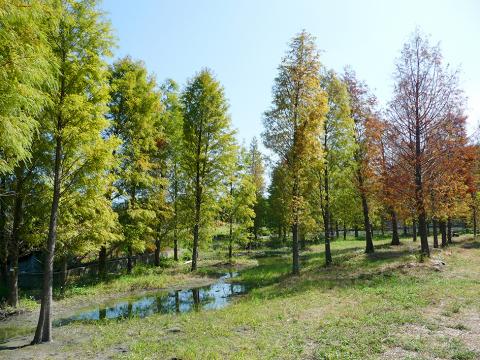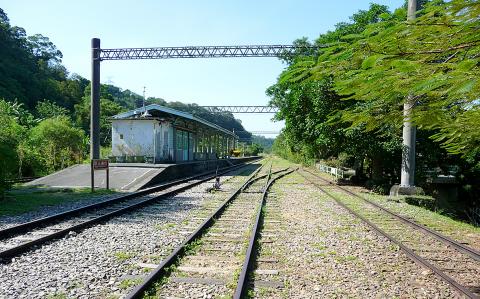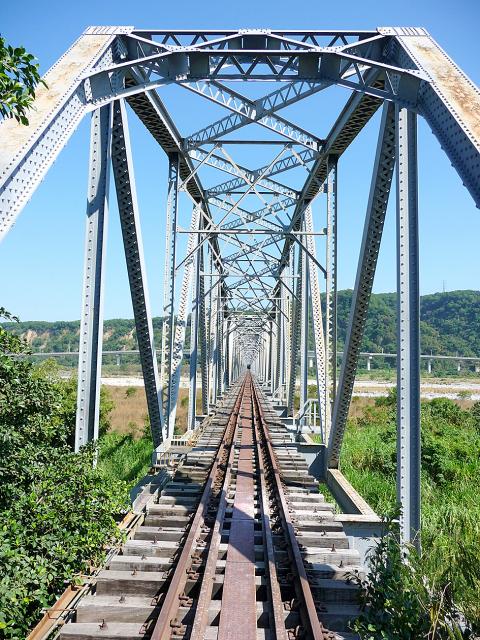I’d cycled down from the mid-elevation mountains that separate Nantou County from Taichung City, then found yet more hills lay between me and the train station where I planned to leave my bike. By the time I reached Taian (泰安), it had been dark for more than an hour. Sightseeing would have to wait until I returned.
Taian TRA Station isn’t in Miaoli County’s Taian Township (泰安鄉), but rather in Houli District (后里區) in Taichung City. It’s less than 500m from the southbank of the Daan River (大安溪), the other side of which belongs to Miaoli County’s Sanyi Township (三義鄉).
When I returned by local train a few days later, the weather was perfect. From the station’s platform, which is elevated well above the plain, I enjoyed excellent views over the surrounding countryside. Looking upriver, I could see the Daan River Iron Bridge (大安溪鐵橋), part of what’s known as the Old Mountain Line (舊山線).

Photo: Steven Crook
Between 1908 and 1998, this bridge carried passenger and freight trains across the Daan River. When the authorities inaugurated a straighter alternative rail route between Houli TRA Station and Sanyi TRA Station, a 15.9-km-long stretch of tracks was retired, as were eight tunnels, three bridges, and two station buildings.
The more famous of the two old stops is Shengsing Station (勝興火車站). At an altitude of 402 meters above sea level, it used to be the highest point on Taiwan’s conventional railway network. Every weekend, Shengsing Station draws crowds of tourists.
Far fewer people go to Taian Railway Cultural Park (泰安鐵道文化園區), which preserves the old Taian station. I broke the short ride between the new and old stations by stopping at a couple of local attractions just off Anmei Road (安眉路).

Photo: Steven Crook
The first was Taian Lovers Tree (泰安情人樹), on the grounds of Taian Elementary School (泰安國民小學). It’s actually a pair of banyan trees. In combination, they create an impressive patch of shade — but I think another tree nearby is more photogenic.
Beside the unnumbered lane that leads to Taian’s much-Instagrammed plantation of bald cypresses, a big tree stands behind a shrine to the local land god. At the time of my visit, it was leafless and perhaps lifeless, yet still wrapped with a red ribbon to symbolize its holy status. The lack of obvious health caused me to wonder: In local popular religion, what happens when a sacred tree dies?
The Secret World of Taian’s Bald Cypresses (泰安落羽松祕境) is smaller than a soccer pitch, and it isn’t the only place in Taiwan where you can see Taxodium distichum, a deciduous conifer species that’s native to the southeastern parts of the US. But on the day I visited, the orange, red and yellow leaves, together with the blue autumn sky, made for a lovely sight.

Photo: Steven Crook
The main station building at Taian Railway Cultural Park is concrete, and while it lacks the allure of the picturesque Japanese colonial-era wooden structure at Shengsing, it has a certain appeal. The entrance is above street level but lower than the actual tracks. These remain in place, and it’s possible to walk northeast along them for about 700m to Daan River Iron Bridge. The old platform looks like an ideal spot for a picnic.
Between the tracks and the hillside, shaped like an artillery shell pointing at the sky, the Earthquake Rehabilitation Monument (震災復興紀念碑) commemorates both the April 21, 1935 tremor (the deadliest earthquake in Taiwan’s recent history, killing 3,422 people) and the reconstruction efforts which followed it. The quake wrecked Longteng Broken Bridge (龍騰斷橋, also known as Yutengping Broken Bridge, 魚藤坪斷橋), which is 4.8km north as the crow flies and now a tourist attraction almost as popular as Shengsing Station.
I rode to the southern end of Daan River Iron Bridge, and was disappointed but not surprised to find it fenced off. The 637-meter-long bridge, which took five years to complete and was declared a municipal-level relic in 2017, looks structurally sound. At some point in the future, hopefully, the authorities will repurpose it for pedestrians and/or cyclists.

Photo: Steven Crook
Before striking out for Taichung’s coastline, about 18km west of Taian TRA Station, I had one more goal. I wanted to snap a few pictures of the badly eroded hills on the other side of the river. Huoyan Mountain (火炎山) is a much-photographed patch of bare ridges that becomes especially eye-catching around sunset. When I came across a multi-story temple just west of Freeway 1, I dashed up the stairs and started shooting. I then spent a minute or two taking in 360-degree views. There was no direction which didn’t tempt me: Too many roads, not enough time!

This is the year that the demographic crisis will begin to impact people’s lives. This will create pressures on treatment and hiring of foreigners. Regardless of whatever technological breakthroughs happen, the real value will come from digesting and productively applying existing technologies in new and creative ways. INTRODUCING BASIC SERVICES BREAKDOWNS At some point soon, we will begin to witness a breakdown in basic services. Initially, it will be limited and sporadic, but the frequency and newsworthiness of the incidents will only continue to accelerate dramatically in the coming years. Here in central Taiwan, many basic services are severely understaffed, and

Jan. 5 to Jan. 11 Of the more than 3,000km of sugar railway that once criss-crossed central and southern Taiwan, just 16.1km remain in operation today. By the time Dafydd Fell began photographing the network in earnest in 1994, it was already well past its heyday. The system had been significantly cut back, leaving behind abandoned stations, rusting rolling stock and crumbling facilities. This reduction continued during the five years of his documentation, adding urgency to his task. As passenger services had already ceased by then, Fell had to wait for the sugarcane harvest season each year, which typically ran from

It is a soulful folk song, filled with feeling and history: A love-stricken young man tells God about his hopes and dreams of happiness. Generations of Uighurs, the Turkic ethnic minority in China’s Xinjiang region, have played it at parties and weddings. But today, if they download it, play it or share it online, they risk ending up in prison. Besh pede, a popular Uighur folk ballad, is among dozens of Uighur-language songs that have been deemed “problematic” by Xinjiang authorities, according to a recording of a meeting held by police and other local officials in the historic city of Kashgar in

It’s a good thing that 2025 is over. Yes, I fully expect we will look back on the year with nostalgia, once we have experienced this year and 2027. Traditionally at New Years much discourse is devoted to discussing what happened the previous year. Let’s have a look at what didn’t happen. Many bad things did not happen. The People’s Republic of China (PRC) did not attack Taiwan. We didn’t have a massive, destructive earthquake or drought. We didn’t have a major human pandemic. No widespread unemployment or other destructive social events. Nothing serious was done about Taiwan’s swelling birth rate catastrophe.